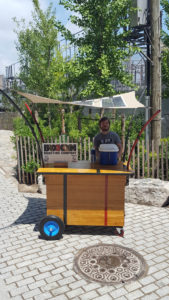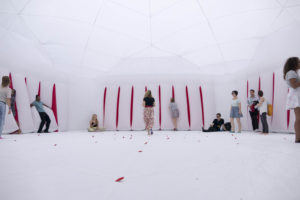New materials are making structures lighter and more portable.

The owner of the iced-coffee cart in Brooklyn Bridge Park, Brooklyn, N.Y., understands the old real estate saw: location, location, location. It makes perfect sense when the coffee cart is made with new, lighter materials available today, making picking up and moving to a better location easier than ever. Many people would never think of the cart as architecture—or real estate. Yet, this portable coffee cart is an example of new materials changing design thinking and augurs an exciting future for architecture.
The concept of a portable structure seems contrary to normal expectations. A building, after all, should be grounded with a solid footing and not move. Nevertheless, Aaron Betsky, architecture critic, curator and dean of the Frank Lloyd Wright School of Architecture, argued in a recent online opinion piece that temporary structures should be given more attention. Citing a number of innovative temporary structures now being created by younger architects and designers, he contrasts this with architecture’s “weightier” tradition.
“We have all been brought up with the idea that the best architecture should be timeless,” Betsky says. “It should rise beyond the vagaries of current fashion and style. It should embody values that are permanent. It should accept, but not be defined by, the rhythms of everyday life. It should last for as long as possible and then make a good ruin. Architecture, in other words, should be monumental, abstract, and difficult and expensive to build.” Betsky counters this assumption in praise of the ephemeral, less expensive and more lively designs he cites in his article: “Let’s enjoy the fact that temporary architecture is letting loose a wave of creativity, inventiveness and serious effectiveness that the discipline has not seen in ages.”*
As Betsky argues, newer, highly innovative temporary structures are being designed by young architects with an urgent need to build, using lightweight materials and loads of creativity. These structures often involve textiles and textile-based composites because these materials have an inherent strength-to-weight ratio that outperforms more traditional and heavier materials.
Fabric-clad superstructures
These new materials vary with the application. Some of the structures use a combination of wood or steel for superstructure and are clad with architectural fabric (much like fabric structures that are anchored solidly to the ground) only these are mobile by design. A case in point would be a pop-up event for the internet search engine corporation Google called “Google on the Beach Lions 2015.” Created like a small waterfront village of pavilions, the Lions 2015 event was anchored by two or three taller, five-sided pagoda-like fabric-roofed structures and surrounded with a variety of different shaped activity booths, somewhat like a fair’s “midway” gaming alley. The two-level pagodas use steel columns and fabric roofs secured by guy wires back to the masts. Projects like this take a standard form and add a twist of creative shapes or details.
Use of composites
A second popular form of portable structures uses composites to reduce weight, usually starting with a fabric mold and concluding with a matrix that makes the ensemble rigid. A good example is Boston-based GLD Architecture’s “Grove” project, a temporary installation on the Rose Fitzgerald Kennedy Greenway in Boston, for the Design Biennial Boston 2015 event. A series of 12 fiberglass pods are grouped together like a grove of trees, placed on stilts and lit at night. Each pod is a hollow form made first in an inflatable fabric balloon and wrapped with a lay-up method of resin-infused fiberglass tape. The pods were created separately and then cut and joined to create a single large shell structure.
The use of inflatable fabric structures has gained increasing interest with architects, according to GLD, because of their adaptability. They “are highly scalable, easily tailored to unique conditions, inexpensive to produce, and simple to erect,” according to information on the company’s website. “They suffer from none of the barriers facing composites. Of course, these characteristics come at the expense of longevity, rigidity and structural capacity, which are the hallmark advantages of fiber matrix composites.”
GLD’s research “recognizes the potential afforded by hybridizing the two disparate fields of inflatables and composites. Using inflatable vinyl bladders as molds for composite production, the expense and inflexibility of the process is radically reduced, with the promise of viably introducing composites to architectural design and building construction.”
Inflatable structures

A third popular form of portables is inflatable structures by themselves, where the material is the structure, held in place by air pressure. The mutability of inflated fabric forms opens up surprisingly creative opportunities for designers, and the reduced weight permitted by low mass fabrics is greatly appreciated when constructing a portable. They are quick to set up and take down and store easily in compact portable storage totes. A recent project for Brown University—a collaborative design process between Pneuhaus (composed of three recently graduated architecture students) and the students of a Brown University STEAM club (Science, Technology, Engineering, Art, & Math)—is an inflatable pavilion intended for use in the central green space on the Brown campus. Inspired by biology and flexibility, the inflated fabric columns are grouped to form a five-sided walled structure with a detachable roof. Each inflated column can act as a door or exit, being detachable from the neighbor columns, making the entire structure accessible from all sides.
Portable and “smart”
A final category integrates smart technology into the portable structure, either through conductive fabrics or high-performance laminations of the enclosing shell. The iced-coffee cart mentioned at the beginning falls into this realm, with laminated flexible photovoltaics in the overhead shade canopy. A 200 W solar array with charging capabilities powers:
- A DC-current refrigeration system to cool the iced coffee
- Lighting
- USB charging slots
- AC power output for the cash registers
The canopy is made of a coated FR-rated stretch fabric; design is by Pvilion for the Brooklyn Roasting Company.
These are a few of the recent examples of fabric-integrated portable structures. Part 2 of the discussion on portable fabric structures, available in the October issue of Fabric Architecture, will go into more depth in each case study to examine the materials used, details of construction, technical aspects of the composites and expectations on future material uses.
Bruce N. Wright, AIA, is an architect and frequent contributor to Advanced Textiles Source, Specialty Fabrics Review, and Fabric Architecture magazines, and a consultant to architects and designers through his company Just Wright Communications.
*“Let’s hear it for temporary architecture.” Aaron Betsky, dezeen blog, March 29, 2016 (www.dezeen.com).
 TEXTILES.ORG
TEXTILES.ORG


